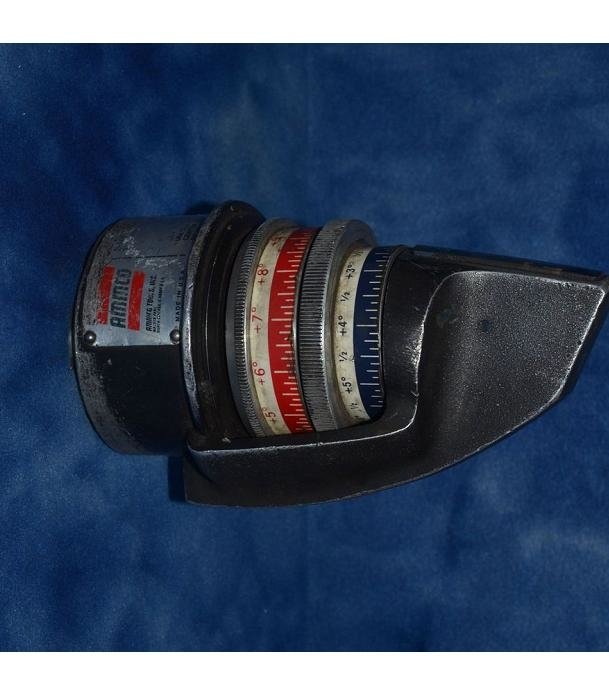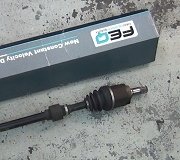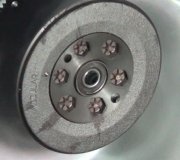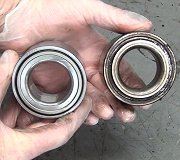Well, I'm going to share more than I know. First of all, when I get my garage set up to where I can use my computer, this looks like a good place to buy turntables. I've had stainless steel plates before that were real expensive, but I don't need that for home use.
It looks like this is an upgraded version of what I used at a Sears Auto Center in the '80s. That equipment used light beams from little 12 volt car bulbs, so it could be hard to see on bright days. The biggest thing I see that concerns me is how the equipment is attached to the wheels. Some older high-end projectors used four fingers that gripped the outside of the wheel lip, and slid under the tire bead as you tightened the clamp. Others went inside the wheel lip, then the clamp was expanded to hold it there. Either way, it was always a worry that one of those fingers would slip, either from the shock when I was banging on something, or when I was pressing against it while reaching in back to put the socket on the adjuster bolt. When I thought that might have happened, I'd recalibrate that projector. That was a real pain with the first computerized aligner I used because to recalibrate one, you had to raise the vehicle on both ends and recalibrate all four projectors at the same time. The newer computer, like the one I got on the auction, lets you recalibrate just one projector at a time.
What I'm referring to is the projector sees an infrared light beam from the other projector on that side of the car, to measure toe, and it has a swinging pendulum and sensor for measuring camber. Those require the projector to be perfectly parallel to the wheel. Calibrating is done with the tire off the turntable with the car jacked up. Nothing has to be level at this point, but it has to be perfectly stable and not rocking or moving. There's a bubble level on each projector that is used only for this calibrating process. You spin the wheel by hand, then when the projector is not parallel to the wheel, the bubble will move in and out as that wheel is rotated. There's three adjustment wheels that position the projector to tweak the angle it's sitting on, and you keep doing that until the bubble never moves in and out as you spin the wheel. With experience, it takes up to a minute to do each one. When learning, it can take a few minutes for each one.
My reason for sharing this is how do you know this equipment is sitting perfectly parallel to the wheel? My procedure eliminates errors caused by a bent wheel, the fingers aren't pushed on equally, or you set a finger on a weld bead on the wheel that holds it out a little.
I couldn't tell how the measurements are taken. With the old Sears equipment, the front projector sent a light beam back to the rear wheel that had a flag, or metal screen on it. That beam also reflected back to the front projector to a screen on the back of it. The problem is that light beam's angle was affected by turning the front wheel in or out from 0.00" toe, as well as if the rear wheel was toed in or out. We had to do a lot of calculating between the readings to figure out what each wheel had. This was further aggravated by the rear wheels being closer together than the front wheels on most cars. With all these variables, this would be great for older rear-wheel-drive cars with solid rear axles, but I wouldn't trust it for the accuracy I needed for front-wheel-drive cars.
As for those specs, a lot of people set their computers up to read in degrees and minutes, as you've observed. I have to work too hard to comprehend it that way. I used to know how to convert in my head from inches of toe to degrees. As I recall, it took twice as many degrees to equal inches, as in.25" equals.50 degrees, for toe. I used degrees and hundredths of a degree for caster and camber, and hundredths of an inch for toe. All alignment computers can be set to read one or two places after the decimal point. Mechanics who set theirs to read to a tenth of a degree are after speed. Make a few adjustments until all the readings change from red to green, and that's close enough. I found that with most of the front-wheel-drive Chrysler models I was working on at the dealership, I was guaranteed no one would come back with a complaint when I set the left front wheel 0.06 degrees camber higher than the right front. The cars also went perfectly straight on my favorite test-drive route. If I had my computer set to read to tenths of a degree, 0.34 would be rounded down to 0.3 degrees, and 0.36 would be rounded up to 0.4 degrees. That looked like I had a 0.1 degrees pull to the left to make up for road crown, which is too much, when I really had 0.02 degrees, which is not enough. Luckily, unlike at Sears, my bosses and service managers never yelled at me once for taking too long on any job, so I was free to do a better alignment to keep our customers happy.
Here's what I found for specs for your car:
1996 Chevrolet Cavalier
L4-2.2L VIN 4
Front Alignment Specifications
CASTER ANGLE, DEGREES [1]
Desired. +4.3
Limits. +3.3 to +5.3
CAMBER ANGLE, DEGREES
Desired. -0.2
Limits. -1.20 to + 0.85
TOTAL TOE, DEGREES. +0.1
[1] Non-adjustable, for inspection purposes only.
Camber agrees with what you listed. Negative means the wheels are tipped in on top. Any time you see a negative camber spec, it is almost always for better cornering at the expense of tire wear. Most cars call for slightly positive camber because that tends to place the vehicle's weight directly over the center of the wheel bearing. On older cars that was to set the weight right over the larger inner wheel bearing which carried the load. The smaller outer bearing was just there to hold the wheel in position.
The acceptable range of roughly plus or minus one degree is absolutely not acceptable. At either of those extremes you'll have almost as much tire wear as you get with older Ford front-wheel-drive cars where camber was not adjustable. Tires on Escorts and Tempos lasted about 15,000 miles. The reason GM allows such a wide range of tolerance is when the car comes in under warranty with a complaint of tire wear or pulling, they will not pay for a warranty alignment if the wheels fall within that huge range. They have a lot of ways like that of getting out of paying for things other manufacturers would cover.
Your camber readings are going to cause a pretty hard pull to the left, although camber affects different car models differently. You have a 0.6 degree pull left. Remember, I used to adjust in a 0.06 degree pull to offset road crown and make the cars go straight.
For many years, GM front-wheel-drive specs were real easy to remember. "0.00" all the way around. 0.00 degrees for front and rear camber, and 0.00" of toe. There might be some confusion with your toe specs. You listed "toe-out", but the numbers show toe-in. I suspect you're using a tape measure, then the 68" is irrelevant to the story. We're interested in the difference between the readings in front and in back of the front tires. The computers go off the front and rear edges of the wheel, so the difference between a 13" or 14" wheel is negligible. When you go from the outer edges of the tires, the difference is going to be greater.
The 0.1 degree spec you listed equates to 0.05". I set all my cars to 0.06" so both wheels were the same. That's 1/16" toe in. Back in the late '70s there were a few new front-wheel-drive models that did call for a little toe-out, thinking the stress of pulling the car would pull them forward and make them perfectly parallel. That thinking has gone away. Almost all cars call for a little toe-in, then road forces pull them back while driving, to make them parallel to each other.
I see the problem with the cam bolts you were given. Those are for use with GM's original struts that don't have the elongated lower hole. The bolt is skinnier except for the small section in the middle. That part stays centered within the hole, then as the rest of the bolt is turned, since it's offset, it moves the head in and out. The special washer has two tabs to lock it to the strut, so the bolt head pushes and pulls on the strut to move it.
You need the bolts that look like that in this photo. You'll see your replacement struts have a shoulder for the offset washers to push on. This bolt will be the same diameter as what you removed. The flat side is only there to key the washers to it.
Image (Click to make bigger)
Thursday, June 20th, 2019 AT 6:11 PM





